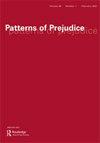种族、鼻子、真相:美国内战前意识中反乌托邦的他者气味
IF 0.8
2区 社会学
Q4 ETHNIC STUDIES
引用次数: 1
摘要
摘要1835年,在因联邦法律、州权利和奴隶权力而引发的内战威胁而震惊美国的“废止权危机”之后,杰罗姆·霍尔盖特以“奥利弗·博洛基特”的笔名出版了他的反乌托邦小说《融合之城的记者》。它假设,如果美国社会成为种族混杂的潜在破坏的牺牲品,非洲体味的存在将使反气味机器变得必不可少。霍尔盖特提出了他对气味和种族的反乌托邦世界观20年后,美国作家艾伦·加兹莱的笔名“Cephas Broadluck”出版了《人类的种族:与格鲁布兰德的旅行》(1856),这是对类似形式的感官和性“融合”的寓言式攻击,还提出嗅觉检测是对白人政治体的种族保护。霍尔盖特和加兹莱的内战前反乌托邦通过鼻子的感官体验将真理和种族的观念结合在一起,而鼻子以前在社会上习惯于通过对整个大西洋世界非洲人气味的虚假意识来感知种族。尽管学者们努力解构现代世界中这种荒谬的信仰和经历,但嗅觉种族主义在现任政治领导人的语言和互联网内部仍在继续。由于这些偏见的看法在许多种族主义者看来是对真理的生物学体验中持续存在,如果关于种族社会建构的学术争论要阻止种族主义、技术化和法西斯现代性在当代西方的回归,学者们就必须更加专注于分析对他者的具体看法。本文章由计算机程序翻译,如有差异,请以英文原文为准。
Race, nose, truth: dystopian odours of the Other in American antebellum consciousness
ABSTRACT It was in 1835, in the wake of the Nullification Crisis that shook the United States with the threat of civil war over federal law, state’s rights and the Slave Power, that Jerome Holgate, under the pseudonym ‘Oliver Bolokitten’, published his dystopian fiction A Sojourn in the City of Amalgamation. It posited the existence of an African body smell that would make anti-odour machines essential if American societies fell prey to the potential ravages of racial miscegenation. Two decades after Holgate offered his dystopian world-view of smell and race, ‘Cephas Broadluck’, a pseudonym for the American author Allen Gazlay, published Races of Mankind: With Travels in Grubland (1856), an allegorical attack on comparable forms of sensory and sexual ‘amalgamation’, also proposing olfactory detection as a racial protection for the white body politic. The antebellum era dystopias of Holgate and Gazlay combined ideas of truth and race through the sensory experiences of the nose, which had previously been socially conditioned to sense racial Others through a false consciousness about the smell of Africans throughout the Atlantic World. Despite the efforts of academics to deconstruct such absurd beliefs and experiences in the modern world, olfactory racism continues in the languages of both current political leaders and within the bowels of the Internet. Because these prejudicial perceptions continue through what seems for many racists to be biological experiences of truth, scholars must focus much more on analysing embodied perceptions of Othering if academic arguments about the social construction of race are to make any inroads against the return of racist, technologized and fascist modernity in the contemporary West.
求助全文
通过发布文献求助,成功后即可免费获取论文全文。
去求助
来源期刊

Patterns of Prejudice
Multiple-
CiteScore
2.50
自引率
0.00%
发文量
11
期刊介绍:
Patterns of Prejudice provides a forum for exploring the historical roots and contemporary varieties of social exclusion and the demonization or stigmatisation of the Other. It probes the language and construction of "race", nation, colour, and ethnicity, as well as the linkages between these categories. It encourages discussion of issues at the top of the public policy agenda, such as asylum, immigration, hate crimes and citizenship. As none of these issues are confined to any one region, Patterns of Prejudice maintains a global optic, at the same time as scrutinizing intensely the history and development of intolerance and chauvinism in the United States and Europe, both East and West.
 求助内容:
求助内容: 应助结果提醒方式:
应助结果提醒方式:


